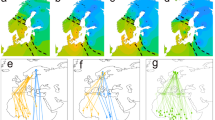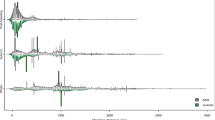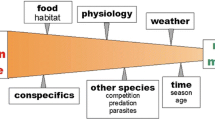Summary
Young avian migrants of many species are able to find their species- or population-specific wintering area without the help of conspecifics. In orientation tests hand-raised birds have been demonstrated to choose appropriate population-specific migratory directions, suggesting a genetic basis to this behaviour. I here report results of a cross-breeding experiment between individuals of two blackcap (Sylvia atricapilla) populations with widely different migratory directions. The orientation of the F1 offspring was intermediate between and significantly different from that of both parental populations (Fig. 2). The variance of individual mean directions in the F1 generation did not increase compared with the parental groups, and the inheritance of migratory directions was not sex-linked. The data provide direct evidence for a genetic basis of migratory directions in birds and demonstrate a phenotypically intermediate mode of inheritance.
Similar content being viewed by others
References
Batschelet E (1981) Circular statistics in biology. Academic Press, London
Beck W, Wiltschko W (1982) The magnetic field as a reference system for genetically encoded migratory direction in pied flycatchers (Ficedula hypoleuca PALLAS). Z Tierpsychol 60: 41–46
Beck W, Wiltschko W (1988) Magnetic factors control the migratory direction of pied flycatchers (Ficedula hypoleuca PALLAS). Proc XIX Int Ornithol Congr, Ottawa 1986: 1955–1962
Berthold P (1973) Relationships between migratory restlessness and migration distance in six Sylvia species. Ibis 115: 594–599
Berthold P (1988) Evolutionary aspects of migratory behavior in European warblers. J Evol Biol 1: 195–209
Berthold P, Querner U (1981) Genetic basis of migratory behavior in European warblers. Science 212: 77–79
Berthold P, Querner U (1982) Genetic basis of moult, wing length, and body weight in a migratory bird species, Sylvia atricapilla. Experientia 38: 801–802
Berthold P, Terrill SB (1988) Migratory behaviour and population growth of blackcaps wintering in Britain and Ireland: some hypotheses. Ring Migr 9: 153–159
Berthold P, Mohr G, Querner U (1990a) Steuerung und potentielle Evolutionsgeschwindigkeit des obligaten Teilzieherverhaltens: Ergebnisse eines Zweiweg-Selektionsexperiments mit der Mönchsgrasmücke (Sylvia atricapilla). J Ornithol 131: 33–45
Berthold P, Wiltschko W, Miltenberger H, Querner U (1990b) Genetical transmission of migratory behavior into a nonmigratory bird population. Experientia 46: 107–108
Brannon EL (1972) Mechanisms controlling migration of sockeye salmon fry. Pacific Salmon Fish Comm Bull 21: 1–86
Brannon EL (1984) Influence of stock origin on salmon migratory behavior. In: McCleave JD, Arnold GP, Dodson JJ, Neill WH (eds) Mechanisms of migration in fishes. NATO Conf Ser IV, Marine Sci 14: 103–111. Plenum Press, New York
Emlen ST (1969) The development of migratory orientation in young indigo buntings. Living Bird 8: 113–126
Emlen ST, Emlen JT (1966) A technique for recording migratory orientation of captive birds. Auk 83: 361–367
Groot C (1965) On the orientation of young salmon (Oncorhynchus nerka) during their seaward migration out of lakes. Behaviour Suppl 14: 1–198
Gwinner E (1968) Artspezifische Muster der Zugunruhe bei Laubsängern und ihre mögliche Bedeutung für die Beendigung des Zuges im Winterquartier. Z Tierpsychol 25: 843–853
Gwinner E, Wiltschko W (1978) Endogenously controlled changes in migratory direction of the garden warbler, Sylvia borin. J Comp Physiol 125: 267–273
Helbig AJ, Berthold P, Wiltschko W (1989) Migratory orientation of blackcaps (Sylvia atricapilla): population-specific shifts of direction during the autumn. Ethology 82: 307–315
Klein H, Berthold P, Gwinner E (1973) Der Zug europäischer Garten- und Mönchsgrasmücken (Sylvia borin und S. atricapilla). Vogelwarte 27: 73–134
Pardi L, Scapini F (1983) Inheritance of solar direction finding in sandhoppers: mass crossing experiments. J Comp Physiol 151A: 435–440
Perdeck AC (1958) Two types of orientation in migrating starlings, Sturnus vulgaris L., and chaffinches, Fringilla coelebs L., as revealed by displacement experiments. Ardea 46: 1–37
Scapini F (1988) Heredity and learning in animal orientation. Monitore Zool Ital (NS) 22: 203–234
Schüz E (1964) Zur Deutung der Zugscheiden des Weißstorchs. Vogelwarte 22: 194–223
Schüz E (1971) Grundriß der Vogelzugskunde. Parey, Berlin Hamburg
Wiltschko W (1983) Compasses used by birds. Comp Biochem Physiol 76A: 709–717
Wiltschko W, Gwinner E (1974) Evidence for an innate magnetic compass in garden warblers. Naturwissenschaft 61: 406
Wiltschko W, Wiltschko R (1988a) Magnetic orientation in birds. Current Ornithol 5: 67–120
Wiltschko W, Wiltschko R (1988b) Magnetic versus celstial orientation in migrating birds. Trends Ecol Evol 3: 13–15
Zink G (1973) Der Zug europäischer Singvögel. Ein Atlas der Wiederfunde beringter Vögel. 1.Lieferung. Vogelzug, Möggingen
Author information
Authors and Affiliations
Rights and permissions
About this article
Cite this article
Helbig, A.J. Inheritance of migratory direction in a bird species: a cross-breeding experiment with SE- and SW-migrating blackcaps (Sylvia atricapilla). Behav Ecol Sociobiol 28, 9–12 (1991). https://doi.org/10.1007/BF00172133
Received:
Accepted:
Issue Date:
DOI: https://doi.org/10.1007/BF00172133




